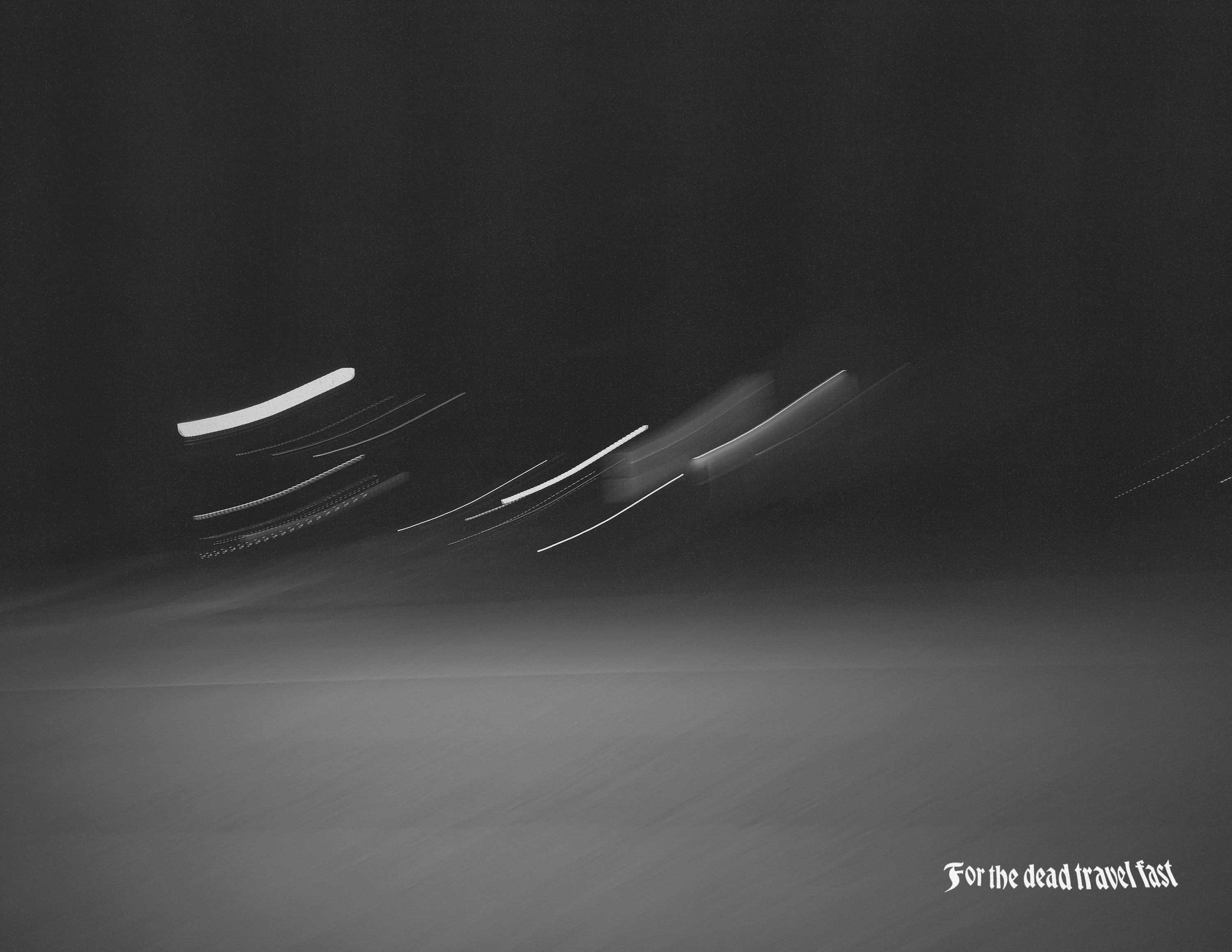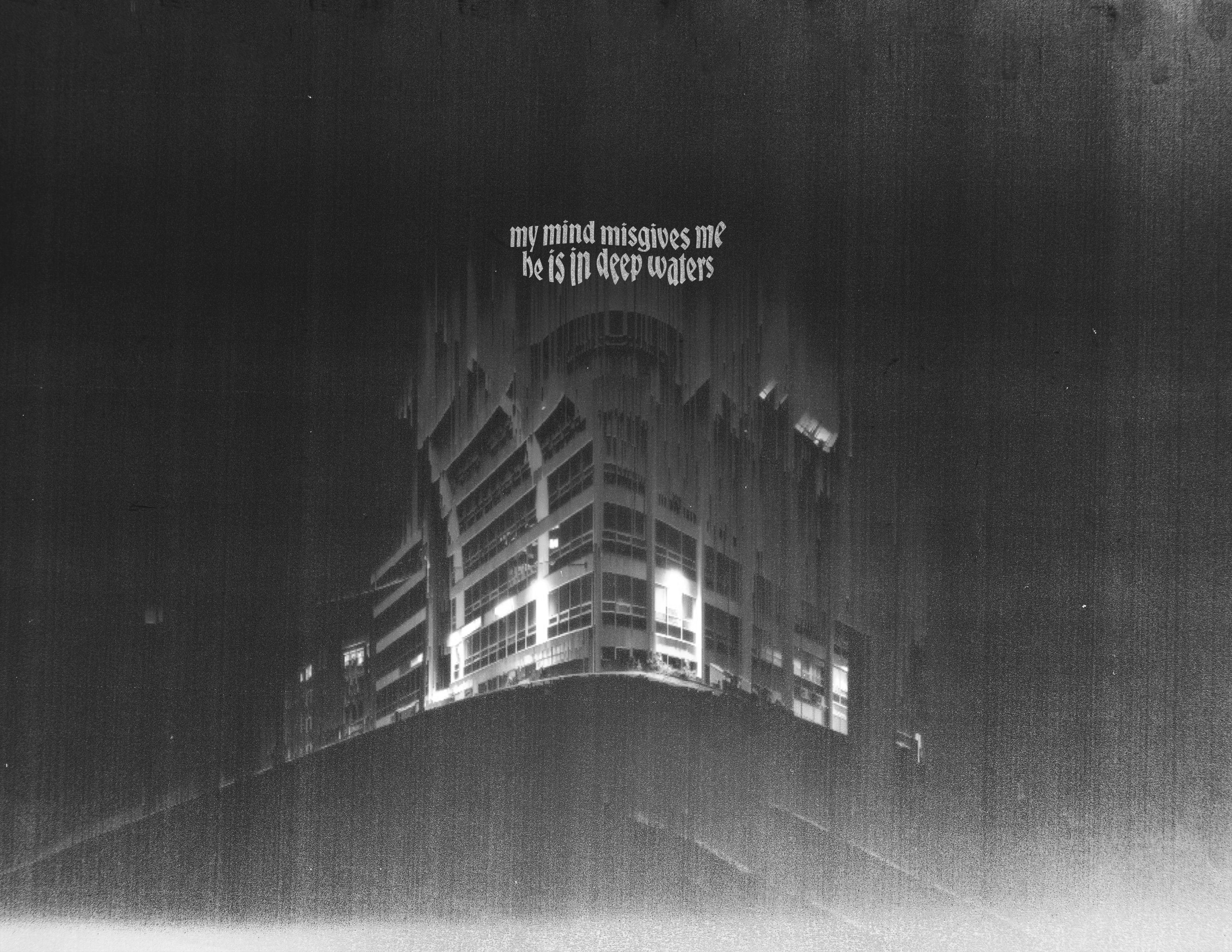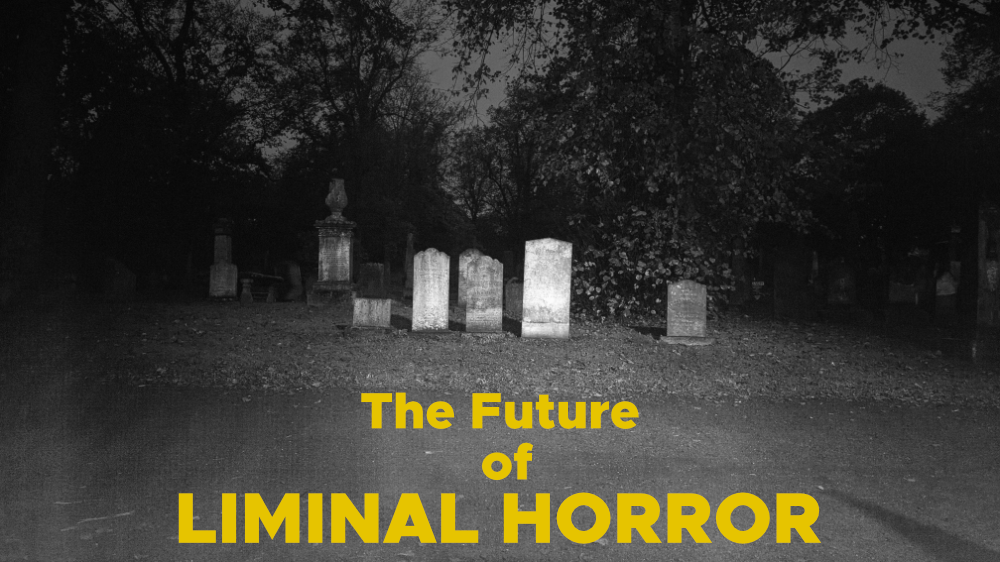March 11, 2024
License Liminal Horror
Liminal Horror Third Party License
This license allows anyone to make adventures, monsters, spells, content or mechanics for Liminal Horror and sell or publish for free.
Rules
If you follow these rules you are allowed to publish free or commercial material based upon or declaring compatibility with Liminal Horror without express permission from Goblin Archives LLC.
Without explicit permission, you may not:
- Copy or re-use the art of Liminal Horror, except those illustrations identified as public domain
- Use the Goblin Archives, Liminal Horror, or Exalted Funeral logos
- State or imply that your work is an official Liminal Horror product, or that it has endorsement from Goblin Archives
You may:
- Use, copy, and modify the text of Liminal Horror Legacy Edition. Liminal Horror Legacy Edition is licensed under CC-BY-SA-4.0.
- Use, reference, and modify the game rules and mechanics.
- Reference any locations, creatures, characters or factions mentioned in Liminal Horror
Restrictions:
- You cannot use AI generated Art or Text in a Liminal Horror compatible publication.
- You cannot make Liminal Horror NTFs.
- You cannot use or copy text from the Investigators Edition or Deluxe Edition that is copyrighted by Goblin Archives and Josh Domanski without a licencing contract.
- You cannot publish work under the Third Party License content that would generally be deemed bigoted or hateful towards minorities, marginalized identities, and/or oppressed classes of any kind. You can use Third Party License for work that critiques bigotry, fascism, TERFs, billionaires, white supremacy, and other oppressive forces.
Legal
The following text must be included somewhere visible within your publication, and on the website or storefront where you promote the product:
[Product name] is an independent production by [Author or Publisher] and is not affiliated with Goblin Archives LLC. It is published under the Liminal Horror Third Party License.
This copyright text must be legibly included somewhere on the product:
Liminal Horror is copyright by Goblin Archives LLC.
Goblin Archives LLC takes no responsibility for any legal claims against your product.
Compatibility logo
You are allowed and encouraged (but are not required to) use one of the “Compatible with Liminal Horror” logo in your product, and on the website or storefront where you promote the product.
[Download]
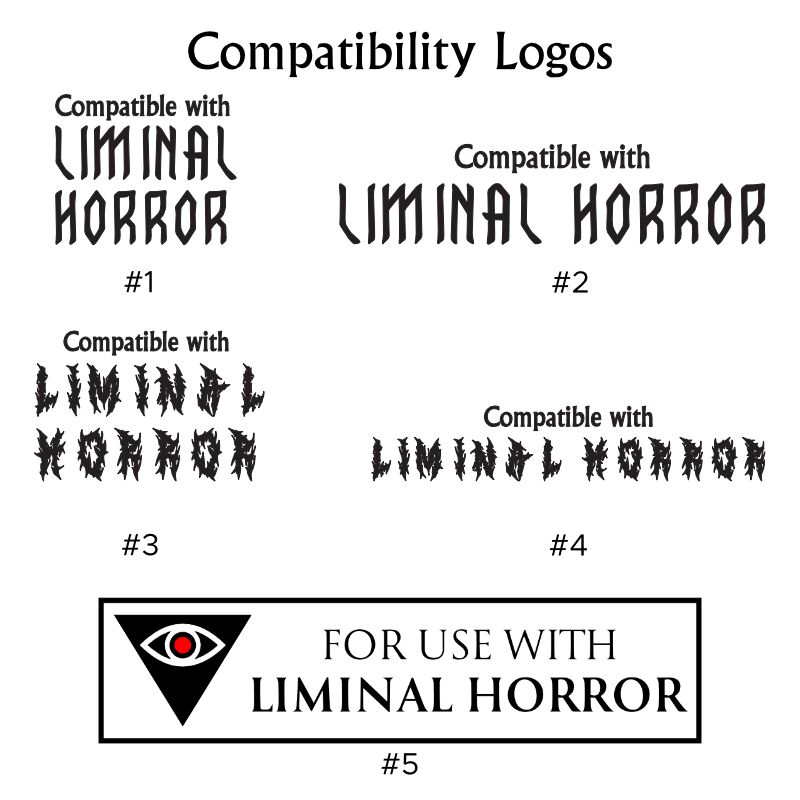
Liminal Horror, CC-BY-SA 4.0 and the Third Party License
Liminal Horror started as a hack of Cairn. The core rules of LIMINAL HORROR are licensed Creative Commons — Attribution-ShareAlike 4.0 International — CC BY-SA 4.0. This means that you can copy and share the text as long as you properly attribute the sections and give those portions the same license.
What this means in practice?
- You can use any of the text, as is, within Liminal Horror Core Rules as long as those parts are attributed and licensed in the same way.
- It also means you can write your own adventure, reference rules and mechanics in your own way, and publish it using the Third Party License above and copywrite your portions of the text (if you want to).
Attribution
Licensing language used the framework created By Odin’s Beard RPG for their Runecairn Third Party License.
Additional language and guidance from the MÖRK BORG Third Party License by Ockult Örtmästare Games and Stockholm Kartell.
Restrictions drawn from Creative Comrades License Agreement v0.3 by JN Butler Art.
January 7, 2023
Appendix Liminal Horror Adventures Facilitator Tools Design Framework
Design Framework for LIMINAL HORROR
Introduction
Liminal Horror as an adaptable system for bringing modern horror to the ttrpg table. This Design Framework is intended to help designers, creators, GMs, and Facilitators to create work that is compatible (or derived from) Liminal Horror.
The core rules are built on the chassis of Carin (and by extension Into the Odd & Knave). This foundation allows for easy to engage with rules that allow people to generate characters quickly, and jump into play.
Liminal Horror intentionally took something that worked well and made a few adjustments (modernization of equipment and language, taking away scars and adding the stress/fallout system based on the damage/scar system). This document showcases what design aspects make LH works well for general ttrpg horror, and what aspects adventure designers can tweak to help reinforce the specific themes/genres of horror and the weird.
Liminality of characters
Liminal is often used to talk about types of places. As I have designed adventures, run games, and talked with other designers, it has become clear that Liminal Horror is not in reference to a place, but the characters themselves.
Characters embark on a process of change as a direct result of the horrors they are forced to grapple with. This transition from “normality” to the weird is the main function of Liminal Horror’s core design. Exposure to monsters, stress, fallout, and being forced to make increasingly difficult choices results in characters that may or may not survive, but will undoubtedly be changed through play.
For more information see a talk I participated in: Writing & Designing Non-Cthulhu Horror | Virtual Horror Con 2022
Setting/Place
The spaces in which these stories are told are extremely important to many types of horror. The cabin in the woods, the mall outside of time and space, a dark hospital. These places function as another character that is just as important as the big bad.
Even seemingly mundane spaces are important for modern horror as they are instantly relatable to the players. Using the schemas of those at the table we are able to imagine these spaces with vivid detail. It is then when you introduce the weird, strange, and horrifying that the juxtaposition hits players (and their characters).
For more information watch Empty Rooms: Architecture and Horror Panel
Liminal Horror and Cops
A value that was not made explicit when writing the core text, but is fundamental to its conception, is that Liminal Horror is written as to not be playing law enforcement (cops, FBI, military). The themes inherent in playing as extensions of those types of systems are problematic, exploitative, and uninteresting.
Reframing as people interested in the paranatural, people in over their heads, journalists, writers, etc is a more fruitful of an outlet.
Any piece of media that you love that is centered around being a cop can be reframed in a ttrpg context as being an investigative journalist of some sort. Columbo as an eccentric writer always looking for the truth to the mystery is more interesting, while also not needing to benefit from a system designed to oppress. Now take your journalist Columbo and throw him at a lich.
Take playing the store clerk that sees something that cannot be believed. The journey that has them stumbling forward into horror beyond imagining, and seeing how that character ends up is much more worthwhile story than a cop trying to jail the shadows.
So if your inclination is to frame the characters as cops, military, or something like that, I ask that you take the time to think of what framing it differently could do for the story. Law Enforcement, military, and government agencies have their place in LH, but it is to act as a natural friction point and adversary. They pose themes worth exploring, just not with players being on the side of oppression.
Reinforcing Specific Themes/Genres in Horror
As I’ve designed official modules for Liminal Horror, I’ve found that the versatility of the core system allows for aspects to be prioritized or adapted to reinforce specific genre desires.
Variables Index
- Character Gen (backgrounds, starting equipment) - recommended start for all adventure writing
- Party Composition (party questions/framing, entanglements)
- Stress (its use and ways to adjust)
- Fallout (creating your own to tie to your specific brand of weird) - second place to go if writing an adventure
- Modular Rules (examples of some I’ve created as a means to support different genre set pieces)
Character Gen
Tailoring your Character Generation is the first aspect I would recommend if you are aiming for a specific genre/theme in your adventure module.
The most straightforward adaptation you can do is to create custom backgrounds, getting to know your character questions, and starting gear that specifically aligns with your module. This can help give an extra level of immersion in the composition of the party.
Below are three different, specific examples of approaches you can take. They have varying degrees of restructuring from the core text.
- From Funnels
- From The Bureau
- From The Mall
From Funnels
For the Appendix introducing Funnel Rules I simplified the character generation procedure by cutting down the amount of questions, and having each background include two items related to the background.
Journalist (Audio Recorder, Camera)
Store Clerk (Lighter, d6 Mini-baseball bat )
One option you could do is choose a specific set of thematic backgrounds with accompanying starting equipment. 6 options should suffice for most tables and give you a range. The more options you provide also help by informing the Facilitator and players the types of characters that would be in this setting. What you include in a table is an act of lore/worldbuilding.
From The Bureau
For The Bureau Josh Domanski and I tailored the character gen (renamed Personally Identifiable Information (PPI) Policy - p. 5) to be a streamlined version of the process in the core text. We included references to Liminal Horror’s questions as an option but embedded a majority of the flavor in the Operational Experience (renamed backgrounds).
Each Operational Experience (The Bureau p. 6-7) had a short description of the background (2-3 sentences) that hinted at why they were in the Monolith. They also alluded to potential complications and goals for the character. Each OE also included 2-3 items as starting equipment.
FINALLY FOUND YOU: You’ve spent years searching for answers. But this is it, you finally know where to find them. Take: Leather Jacket (1 armor), old photograph (The Bureau p. 6)
GHOST HUNTER: Ever since your show was canceled, you’ve been trying to go legit. They haven’t returned your calls, but there’s no harm in showing up in person. Take: Spirit box, thermal camera, EVP wrist recorder. (The Bureau p. 6)
COMPLIANCE OFFICER: Records show that the Bureau has missed the last 51 annual safety inspections. This oversight simply cannot stand. Take: Inspection form,flashlight (d6), all-in-one measurement/testing tool. (The Bureau p. 7)
This option expands on the custom background/equipment combo by baking in more implied world building and characterization with the short prompt. Creating backgrounds that have a blurb and equipment can be a way for you to reinforce the setup and give players a starting point that has some built-in stakes.
- You could take it a step further and add some more in depth characterizations to the prompts to give a tailored setup.
- You could give (either to each of them or have a roll table) each character a hidden goal/drive.
From The Mall:
For The Mall I rewrote the entire character generation for Liminal Horror from the ground up. A web-based version can be found on the Liminal Horror website.
I started by having players add to the mall (setting) as a means of building shared vision for the space. They then dove deeper into their characters, specifically answering:
Why Are You At The Mall?
How Does Your Character Feel About The Mall?
The starting gear was rewritten to be mall themed, with little notes to reinforce the setting (like what uniform they wear if they are an employee, etc).
Creating a custom procedure for creating a character can be a great way to modify character gen to produce a specific style of starting character. It puts not only the characters into the space of being a part of the setting but helps prime players. A simple framework could be:
- Step 1: Adding to the setting (mall, town, organization)
- Step 2: Ability Scores & HP (standard core rules)
- Step 3: Investigator Details (use this section to ask guiding questions that establish the characters’ connection to the setting)
- Step 4: Starting Gear (write a starting gear table that aligns to the tone and theme of the scenario)
- Step 5: General Info (age, look, name, final touches)
- Step 6: Entanglements (see the following section for details)
Party Composition
“An elite team composed of lone wolves, nerds, thieves, marginalized, heretics and enemies of the academic bureaucracy.” - Shin Gojira 2016
Getting to the heart of what brings the party together is another variable that can be adjusted to reinforce theme, tone, and setup. Sometimes it’s implied based on setup (The Mall has people as customers or employees) or is it more open to interpretation (The Bureau has a few questions that can be influenced by people’s Operational Experiences - but serendipity can easily be the culprit).
Party composition is often made up of:
- Party Questions
- Entanglements - Connections
- Entanglements - Bonds
Party Questions
One way to adjust the system for your module is to create a unifying setup that brings the party together. Liminal Horror Party Questions introduces some options that could bring the group together. You could write in a specific unifying prompt for the scenario.
For Bayocean one of the options I will be using as a frame for the pamphlets is having the PCs together making a radio show/podcast on the area. This framing gives a starting unification of the group and will allow for some context/equipment at the impetus. While not necessary for the flow of the scenarios, providing an option for Party composition can be worthwhile.
Entanglements - Connections
Having players create at least one NPC that they have a connection to is a fantastic way to bring them deeper into the setting. In The Mall players create (or choose) an NPC that their character has a connection with. This gives an immediate thread for the Facilitator to tug on, building stakes and creating narrative buy in for the characters. (Spoiler: I would often use one of the NPC connections as the first victims of the monster in The Mall, establishing what’s at stake immediately after things break bad)
Entanglements - Bonds
While in the core text this is listed as optional, for The Mall I made it a built in step for players. It begins to create a web of connection and gives a starting point for characters in relation to each other. This is also great because of how play impacts and changes these relationships (remember, the Liminal Horror is how characters change in the face of these events, and often it is not for the best).
Stress
Stress is a great resource for Facilitators. It allows them to put characters at risk, and can help control pacing. Since it is a modular addition specifically for Liminal Horror, altering/adjusting/removing stress is something that is completely possible.
Stress serves two functions:
- To be a non-physical threat to players - directly in relation to the weird
- It is the means in which Fallout is triggered, thereby permanently changing characters through the weird.
Depending on the themes, tone, and need in your adventure, you can adjust how stress gets used. It will be important to make the adjustment explicit for the Facilitator (and support them in explaining it to players).
Possible Adjustments
In Place of Stress: One adjustment could be introducing a variable in the place of stress (or to go alongside it). In The Mall, there is a mechanic called Whisper Cards. For this module the trigger for Whisper Cards would replace getting stress. This only occurred for the player taking an action. So while other characters got stress in a situation, the one taking the most risk got a Whisper Card instead. This mean while stress was still in play (especially for attacking HP and establishing stakes) Whisper Cards become the main conduit for the weird. (This decision was to reinforce the being replaced theme of the module, and was a way to integrate a modular rule - see below).
Drop Connection To Fallout: Another adjustment could be to drop the connection to Fallout. Having stress simply be a risk akin to physical damage. This removes the characters being shifted by the weird, but maintains the resource tension by giving another avenue to impact HP and decrease stats. In a straight slasher style module I could see omitting fallout (see the Fallout Considerations below).
Shift to a Build Up System: One other option is to have Stress build up over time, accruing until something happens (with the trigger being specific to a modular rule created for your scenario - see below).
Note: Liminal Horror explicitly is designed to avoid playing into stigmatizing mental health. If you create a new stress trigger that is not Fallout it needs to not step into historical tropes of sanity systems and its ilk. If there’s a mechanical impact to rules, be careful what you name it.
Fallout
Fallout is the rule that directly entwines Liminal Horror with the weird. When designing Fallout, my intent was to use it as a means of entangling characters. It functions as a narrative progression (and sometimes mechanical one) and makes explicit how characters have changed as a result of the stress caused by the weird.
The generic Fallouts written for Liminal Horror are fun and each provide a different narrative hook that could have sessions built around them.
If you are writing your own Liminal Horror scenario, one of the first things I recommend doing to reinforce your intended theme/tone/monster/etc is create a few adventure specific Fallouts. This align the weird that happens to the players to the horror being written in the adventure.
For the Mall
I wrote Fallouts that relate to the Children of Ammon infecting the Carpenter Mall:
01: You hear the choir’s song, its melody is an ever-changing constant. ▶ Increase your CTRL by 1d4.
07: Sounds begin to manifest visually. At first, they are just shapes and colors, but they slowly start to become more distinct. Their form is unlike anything you’ve ever seen.
For The Bureau
We leaned in to Fallout as a major facet of the themes of corruption. The Shadow is invading The Monolith, and as characters get closer to the goal they become infected by shadow, getting stronger (hopefully strong enough to overcome the Director) but potentially losing themselves in the process:
02: Halo of Black Flame: It forms over your head, faint at first, but the longer you spend in this place, the more pronounced it becomes. Roll d4 and add it to your CTRL (max 18).
07: Arm of Night: The flesh from your right arm sloughs off and is replaced by sharp angles made of shadow (acts as a d8 weapon).
11: Maggot Warren: Maggots made of shadow burrow in your flesh. They grant a limited ability to manipulate shadows. You can move 150lb objects up to 100ft. Every time you use this the burrowing of the maggots causes d4 Stress to anyone that sees.
Fallout can be a thing that is shifted or omitted (see Stress, Possible Adjustments above), but it is also one of the easiest ways to strengthen the connection between the system, the weird, and your scenario. Character Gen and Fallouts are two things I always adjust for my Liminal Horror adventures and are the first places I recommend people look at when trying to write their own.
Modular Rules
One of the things that I have loved doing for Liminal Horror is creating modular rules/procedures that can be used in both campaign play and short for adventure writing.
What I have found is that since there is a strong central ruleset, you can adjust modular rules to meet needs of play, adding and removing them over time based on the story being told.
For The Mall I used Whisper Cards as a modular rule that specifically reinforced The Thing/being replaced/not knowing who has been replaced. If I were to continue after the events of the adventure, I may drop the Whisper Cards and stay with the core rules, adding a different modular rule if the need arose.
This adaptability can be leveraged in your own writing. Creating rules/procedures that specifically reinforce a tone/theme/event sequence can elevate play but doesn’t break the table or narrative.
Some examples of other modular rules that I’ve put out (or are planning on putting out):
These can be in addition to the core rules, or adapted to replace/work alongside stress & fallout. If there is a complicated or genre specific thing that happens (especially in relation to character change), creating a custom rule or procedure can be a great way to really tailor the system to your adventure.
I use the term modular because it truly is. Liminal Horror is built in such a way to facilitate telling interesting horror stories from a multitude of genres.
(Design Framework © 2023 Goblin Archives)
December 25, 2022
Liminal Horror Adventure
#Dungeon23 Prep
Where Goblin Archives attempts to write a room a day for a year and see if a traditional mega-dungeon will work with Liminal Horror.
Origin of
For those not aware, Sean McCoy Win Conditions posted a preview project he was doing called Dungeon23. The original tweet is included below. Here is a more in-depth post he made about the project #dungeon23.
The Below A LIMINAL HORROR MEGADUNGEON
For my entry we will be diving into a mega-dungeon that lays below an “abandoned” island (in proximity of Bayocean, and based on Hashima Island). Peliminarily titled The Below/Caverns of Hashima.
Evacuated decades prior, small pockets of people still make this place their home, despite the dangers. Residents of the island know better than venturing too far below.
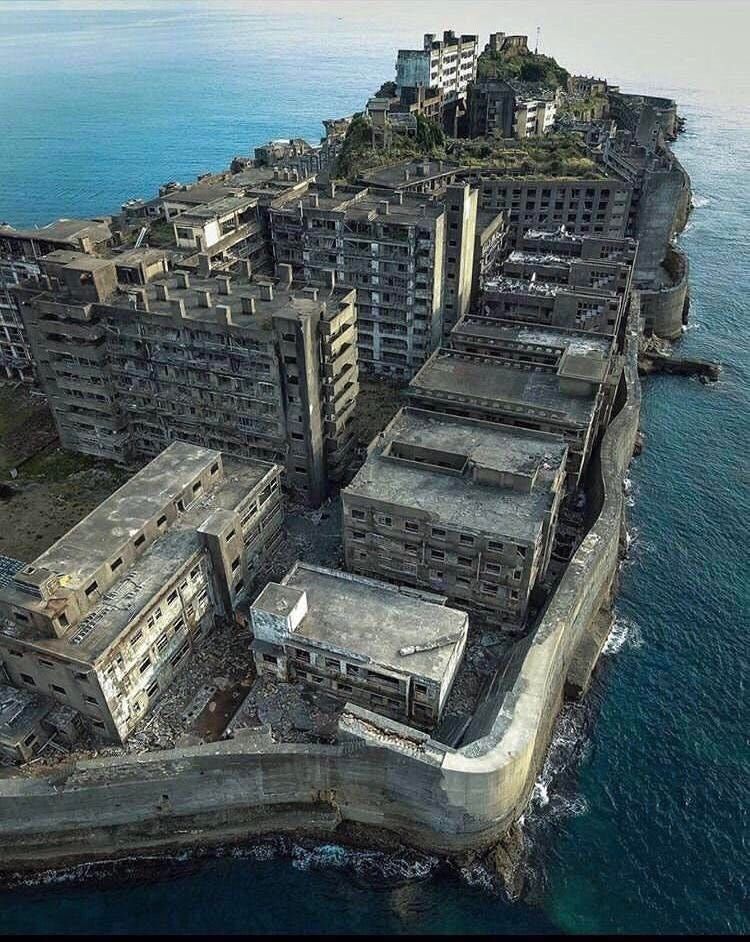
CROSS SECTION OF MAP
Here is a cross section of my dungeon. 12 levels lay below the island.
While 1-3 were utilized by the more modern residents of the island. Levels 4-12 existed long ago. There was a reason why they were sealed away…
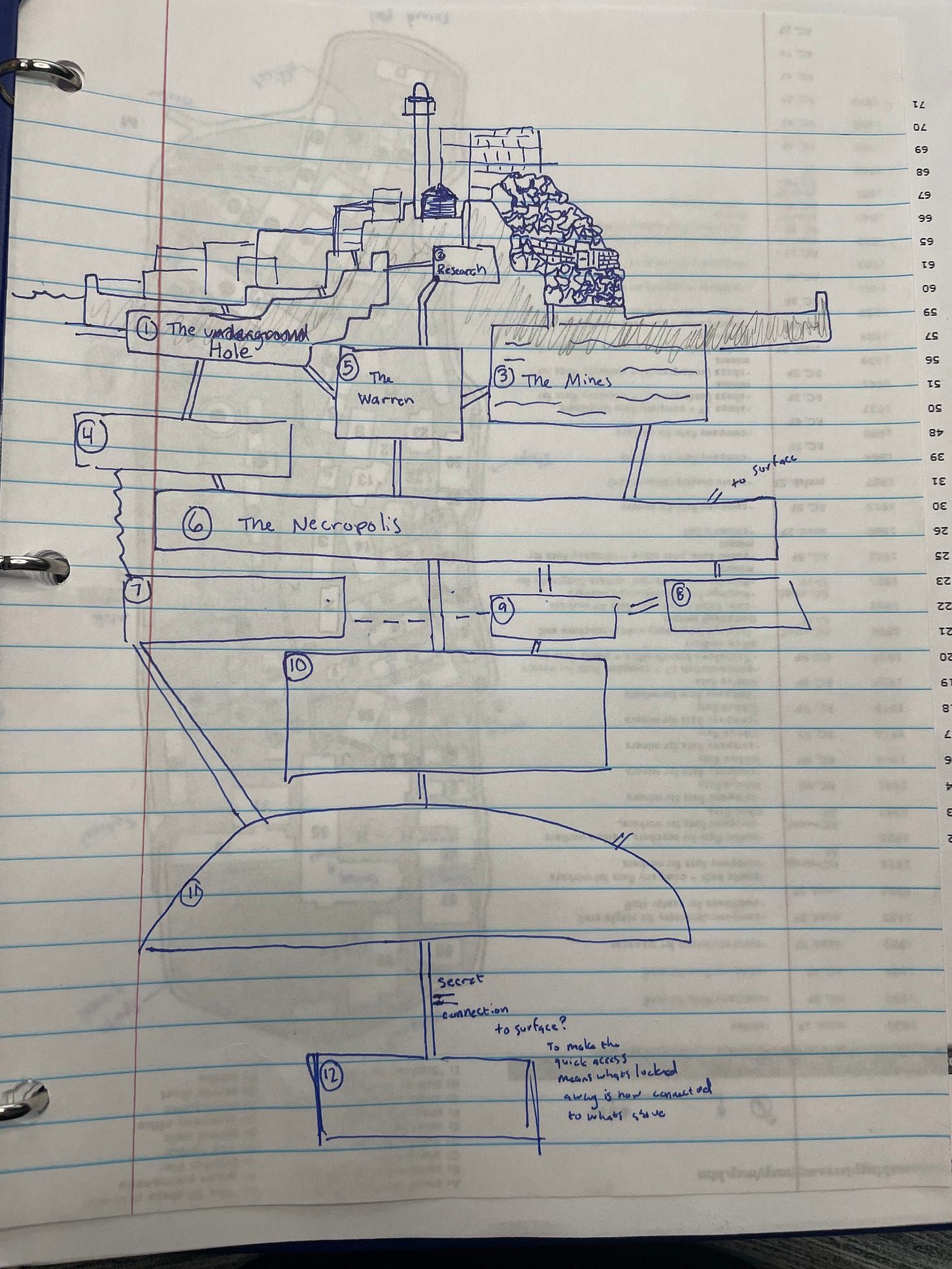
SURFACE
I will write some descriptions (point crawl/zones style) for the surface. Some factions will reside above, with most of the detail waiting for what awaits underground. I’ll be adapting this map to a functional surface village zones.
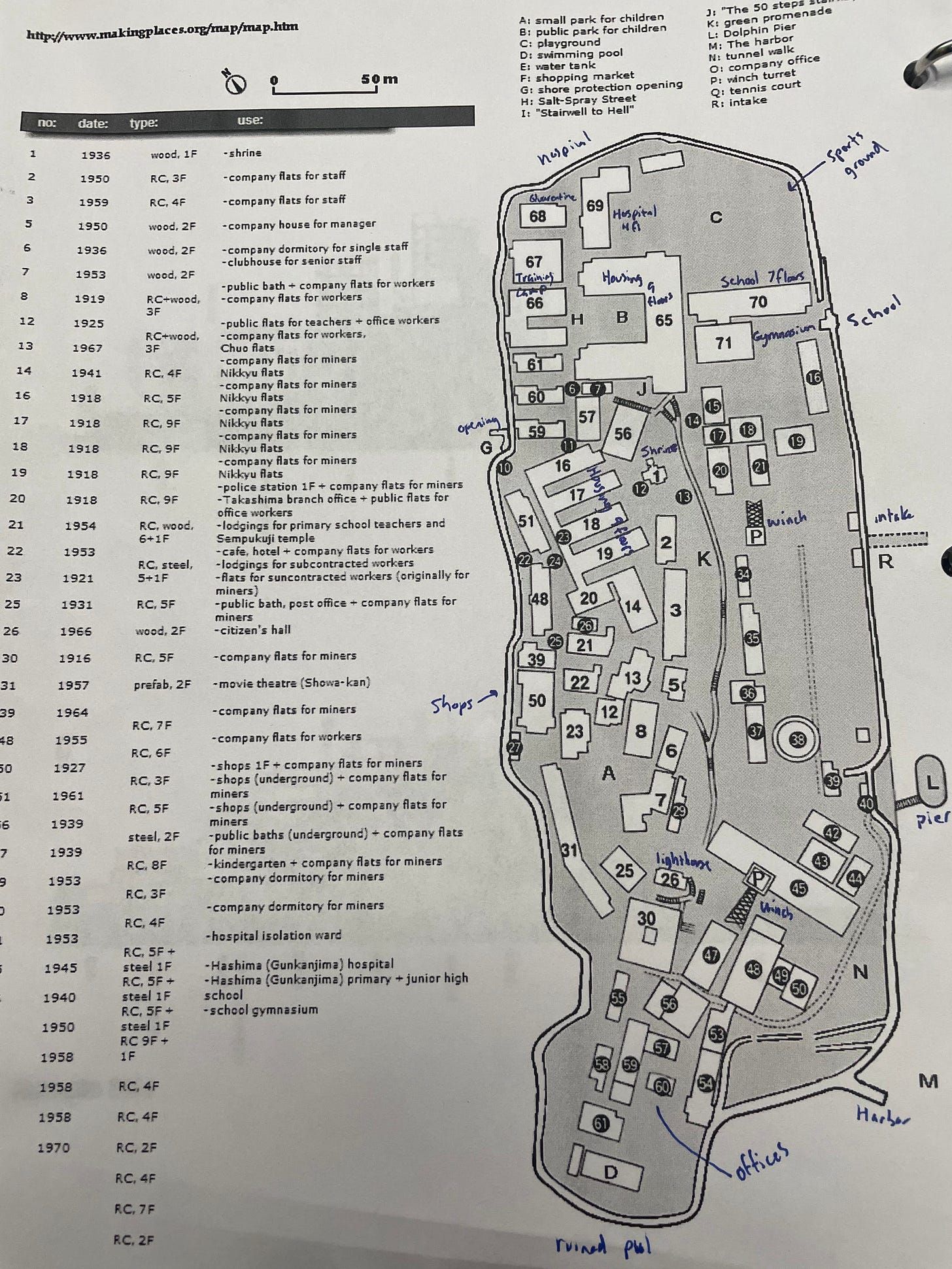
LEVEL 1: THE HOLE
This level acts as the underground section of the above city. It is where some of the more nefarious humans have set up shop, far away from prying eyes of governments, corporations or externally imposed “laws.”
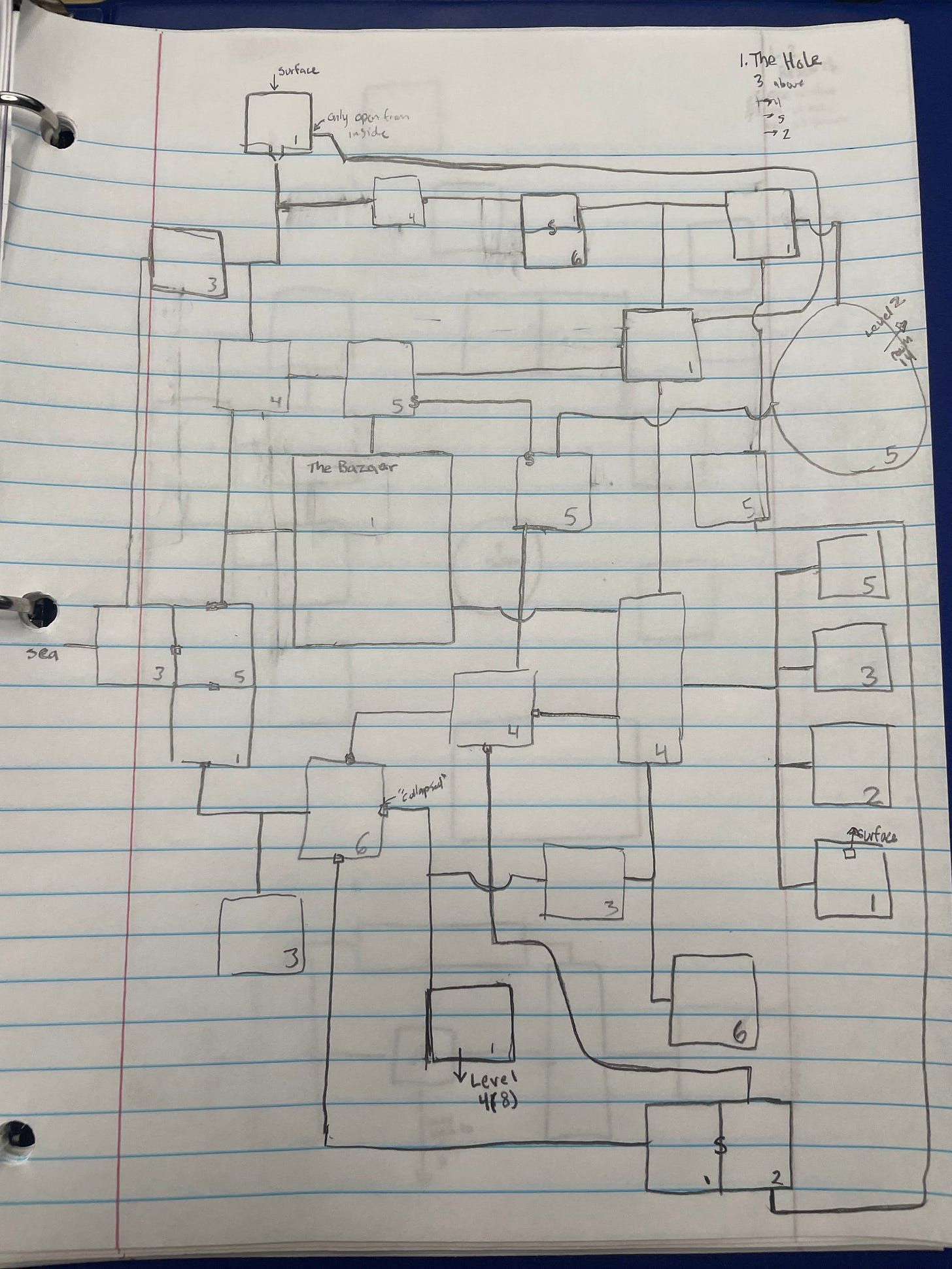
LEVEL 2: RESEARCH
I always seem to include corporations/governments doing shady shit in my work, and this won’t be any different. As with most LH work, there will be a paranatural bend to it. Since I haven’t started writing the dungeon, I’m not sure what the problem they set in motion will be, but I have a feeling it will allow me to justify a LH take on “2d6 Goblins”
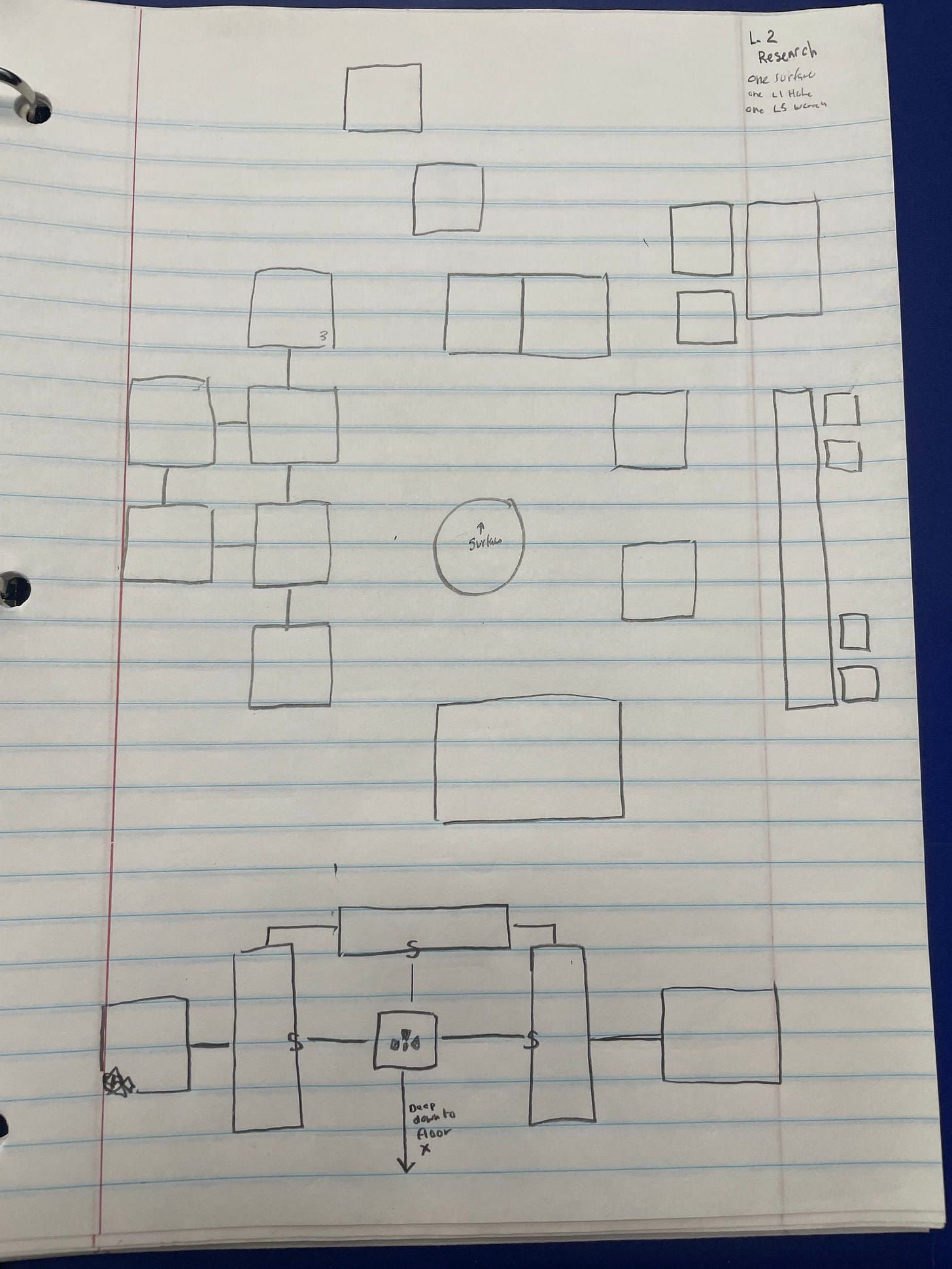
What I’m reading to get prepared:
I find having clear touchstones and exemplars help me anchor my writing/process. I have a feeling that each level will end up having very specific touchstones/playlists/read-lists. Here is what I’m reading in the leadup.
Modules:
Manga:
Films:
As a special treat:
Only for my newsletter crew, here’s a peak at some of the possible things that may show up (a glimpse at the notes app)
- Mage making human animal hybrids
- Godzilla children (like the spawn from the tail of Shin Godzilla)
- Fungal cult
- LH style “Goblins”
- Elephants foot
- Flooded part of the mines (you can unflood)
- twist on undead/skeleton - Porcelain noroi masked
- Shapeshifter…mimic
- Witch/seer
- Tremors monster thing.
- Ceiling of doors
<iframe src="https://goblinarchives.substack.com/embed" width="480" height="320" style="border:1px solid #EEE; background:white;" frameborder="0" scrolling="no"></iframe>
Subscribve to the newsletter here: Goblin Archives’ The Stacks






